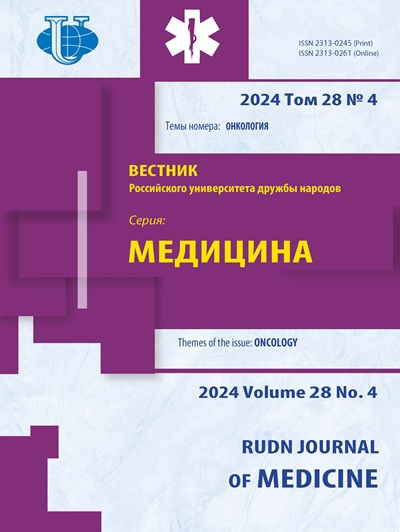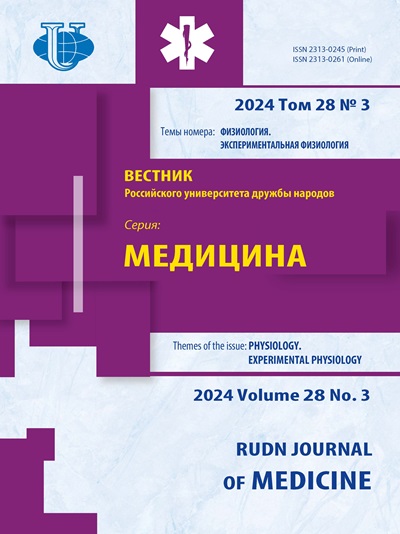The role of endogenous H2S in experimental metabolic syndrome
- Authors: Birulina J.G.1, Ivanov V.V.1, Buyko E.E.1, Voronkova O.V.1, Chernyshov N.A.1, Gusakova S.V.1
-
Affiliations:
- Siberian State Medical University
- Issue: Vol 28, No 3 (2024): PHYSIOLOGY. EXPERIMENTAL PHYSIOLOGY
- Pages: 331-339
- Section: PHYSIOLOGY. EXPERIMENTAL PHYSIOLOGY
- URL: https://journals.rudn.ru/medicine/article/view/40853
- DOI: https://doi.org/10.22363/2313-0245-2024-28-3-331-339
- EDN: https://elibrary.ru/AFKRGE
Cite item
Full Text
Abstract
Relevance. The gasotransmitter hydrogen sulphide (H2S) is a well-known signalling molecule that is involved in the regulation of a wide range of cellular functions in both health and disease. Its biological effects in obesity and metabolic syndrome (MetS) have been investigated. It is a promising pharmacological target for the correction of MetS and associated diseases. The aim of this study is to investigate the role of endogenously produced H2S in the pathogenesis of metabolic disorders in experimental Met S. Materials and Methods. A high-fat and high-carbohydrate diet was used to induce MS in male Wistar rats. The body and adipose tissue weights of the animals were determined. The animals body and adipose tissue weights were measured. Indicators of carbohydrate and lipid metabolism in the blood serum were determined with the use of reagent kits. Additionally, the levels of reactive oxygen species (ROS) and reduced glutathione (GSH) were analyzed in adipose tissue through photometric analysis. The concentration of H2S in blood serum and adipose tissue, as well as H2S production by adipocytes, was measured spectrophotometrically. Results and Discussion. H2S concentrations in blood serum, adipose tissue and adipocyte H2S production were found to decrease in animals with hyperglycaemia and insulin resistance. Additionally, a negative correlation was observed between the H2S content and production in the adipose tissue of rats with the mass of visceral adipose tissue. Furthermore, a negative relationship was found between the concentrations of glucose, insulin, leptin, ROS and the level of H2S in blood serum and adipose tissue. In contrast, the increase in glutathione (GSH) in adipocytes was directly correlated with the increase in hydrogen sulfide (H2S) in serum and adipose tissue cells. Conclusions. The regulatory effect of H2S on target cell function has been extensively studied. However, its role in the development and progression of MetS remains unclear. Our work demonstrates that under conditions of metabolic pathology, there is a decrease in the serum concentration of H2S and its production in adipose tissue. This decrease correlates with the development of obesity, hyperglycemia, insulinemia, leptinemia, and redox imbalance.
About the authors
Julia G. Birulina
Siberian State Medical University
Author for correspondence.
Email: birulina20@yandex.ru
ORCID iD: 0000-0003-1237-9786
SPIN-code: 4878-1005
Tomsk, Russian Federation
Vladimir V. Ivanov
Siberian State Medical University
Email: birulina20@yandex.ru
ORCID iD: 0000-0001-9348-4945
SPIN-code: 4961-9959
Tomsk, Russian Federation
Evgeny E. Buyko
Siberian State Medical University
Email: birulina20@yandex.ru
ORCID iD: 0000-0002-6714-1938
SPIN-code: 6383-3580
Tomsk, Russian Federation
Olga V. Voronkova
Siberian State Medical University
Email: birulina20@yandex.ru
ORCID iD: 0000-0001-9478-3429
SPIN-code: 8005-8110
Tomsk, Russian Federation
Nikita A. Chernyshov
Siberian State Medical University
Email: birulina20@yandex.ru
ORCID iD: 0000-0002-4008-5606
SPIN-code: 7863-9900
Tomsk, Russian Federation
Svetlana V. Gusakova
Siberian State Medical University
Email: birulina20@yandex.ru
ORCID iD: 0000-0001-5047-8668
SPIN-code: 8973-8056
Tomsk, Russian Federation
References
- Kolluru GK, Shen X, Yuan S, Kevil CG. Gasotransmitter Heterocellular Signaling. Antioxid Redox Signal. 2017;26(16):936-960. doi: 10.1089/ars.2016.6909
- Cirino G, Szabo C, Papapetropoulos A. Physiological roles of hydrogen sulfide in mammalian cells, tissues, and organs. Physiol Rev. 2023;103(1):231-276. doi: 10.1152/physrev.00028.2021
- Hendriks KD, Maassen H, van Dijk PR, Henning RH, van Goor H, Hillebrands JL. Gasotransmitters in health and disease: a mitochondria-centered view. Curr Opin Pharmacol. 2019;45:87-93. doi: 10.1016/j.coph.2019.07.001
- Liu YH, Lu M, Hu LF, Wong PT, Webb GD, Bian JS. Hydrogen sulfide in the mammalian cardiovascular system. Antioxid Redox Signal. 2012;17(1):141-185. doi: 10.1089/ars.2011.4005
- Nagpure BV, Bian JS. Brain, Learning, and Memory: Role of H2S in Neurodegenerative Diseases. Handb Exp Pharmacol. 2015;230:193-215. doi: 10.1007/978-3-319-18144-8_10
- Comas F, Moreno-Navarrete JM. The Impact of H2S on Obesity-Associated Metabolic Disturbances. Antioxidants (Basel). 2021;10(5):633. doi: 10.3390/antiox10050633
- Pandey T, Pandey V. Hydrogen sulfide (H2S) metabolism: Unraveling cellular regulation, disease implications, and therapeutic prospects for precision medicine. Nitric Oxide. 2024;144:20-28. doi: 10.1016/j.niox.2024.01.004
- Filipovic MR, Zivanovic J, Alvarez B, Banerjee R. Chemical Biology of H2S Signaling through Persulfidation. Chem Rev. 2018;118(3):1253-1337. doi: 10.1021/acs.chemrev.7b00205
- Wu Z, Barayeu U, Schilling D, Dick TP, Pratt DA. Emergence of (hydro)persulfides as suppressors of lipid peroxidation and ferroptotic cell death. Curr Opin Chem Biol. 2023;76:102353. doi: 10.1016/j.cbpa.2023.102353
- Bełtowski J, Wiórkowski K. Role of Hydrogen Sulfide and Polysulfides in the Regulation of Lipolysis in the Adipose Tissue: Possible Implications for the Pathogenesis of Metabolic Syndrome. Int J Mol Sci. 2022;23(3):1346. doi: 10.3390/ijms23031346
- Gheibi S., Jeddi S., Kashfi K., Ghasemi A. Effects of Hydrogen Sulfide on Carbohydrate Metabolism in Obese Type 2 Diabetic Rats. Molecules. 2019;24(1):190. doi: 10.3390/molecules24010190
- Birulina JG, Ivanov VV, Buyko EE, Bykov VV, Smagliy LV., Nosarev AV, Petrova IV, Gusakova SV, Popov OS, Vasilev VN. High-fat, high-carbohydrate diet-induced experimental model of metabolic syndrome in rats. Bulletin of Siberian Medicine. 2020;19(4):14-20. (In Russian). doi: 10.20538/1682-0363-2020-4-14-20
- Li L, Bhatia M, Zhu YZ, Zhu YC, Ramnath RD, Wang ZJ, Anuar FB, Whiteman M, Salto-Tellez M, Moore PK. Hydrogen sulfide is a novel mediator of lipopolysaccharide-induced inflammation in the mouse. FASEB J. 2005;19(9):1196-1198. doi: 10.1096/fj.04-3583fje
- Mok YY, Atan MS, Yoke Ping C, Zhong Jing W, Bhatia M, Moochhala S, Moore PK. Role of hydrogen sulphide in haemorrhagic shock in the rat: protective effect of inhibitors of hydrogen sulphide biosynthesis. Br J Pharmacol. 2004;143(7):881-889. doi: 10.1038/sj.bjp.0706014
- Liu L, Zou P, Zheng L, Linarelli LE, Amarell S, Passaro A, Liu D, Cheng Z. Tamoxifen reduces fat mass by boosting reactive oxygen species. Cell Death Dis. 2015;6(1): e1586. doi: 10.1038/cddis.2014.553
- Revenko O, Pavlovskiy Y, Savytska M, Yashchenko A, Kovalyshyn V, Chelpanova I, Varyvoda O, Zayachkivska O. Hydrogen Sulfide Prevents Mesenteric Adipose Tissue Damage, Endothelial Dysfunction, and Redox Imbalance From High Fructose Diet-Induced Injury in Aged Rats. Front Pharmacol. 2021;12:693100. doi: 10.3389/fphar.2021.693100
- Feng X, Chen Y, Zhao J, Tang C, Jiang Z, Geng B. Hydrogen sulfide from adipose tissue is a novel insulin resistance regulator. Biochem Biophys Res Commun. 2009;380(1):153-159. doi: 10.1016/j.bbrc.2009.01.059
- Abramavicius S, Petersen AG, Renaltan NS, Prat-Duran J, Torregrossa R, Stankevicius E, Whiteman M, Simonsen U. GYY4137 and Sodium Hydrogen Sulfide Relaxations Are Inhibited by L-Cysteine and KV7 Channel Blockers in Rat Small Mesenteric Arteries. Front Pharmacol. 2021;12:613989. doi: 10.3389/fphar.2021.613989
- Katsouda A, Szabo C, Papapetropoulos A. Reduced adipose tissue H2S in obesity. Pharmacol Res. 2018;128:190-199. doi: 10.1016/j.phrs.2017.09.023
- Yang G, Ju Y, Fu M, Zhang Y, Pei Y, Racine M, Baath S, Merritt TJS, Wang R, Wu L. Cystathionine gamma-lyase/hydrogen sulfide system is essential for adipogenesis and fat mass accumulation in mice. Biochim Biophys Acta Mol Cell Biol Lipids. 2018;1863(2):165-176. doi: 10.1016/j.bbalip.2017.11.008
- Ren H, Liu TC, Lu Y, Zhang K, Xu Y, Zhou P, Tang X. A comparison study of the influence of milk protein versus whey protein in high-protein diets on adiposity in rats. Food Funct. 2021;12(3):1008-1019. doi: 10.1039/d0fo01960g
- Alkhouri N, Eng K, Cikach F, Patel N, Yan C, Brindle A, Rome E, Hanouneh I, Grove D, Lopez R, Hazen SL, Dweik RA. Breathprints of childhood obesity: changes in volatile organic compounds in obese children compared with lean controls. Pediatr Obes. 2015;10(1):23-9. doi: 10.1111/j.2047-6310.2014.221.x
- Comas F, Latorre J, Ortega F, Arnoriaga Rodríguez M, Lluch A, Sabater M, Rius F, Ribas X, Costas M, Ricart W, Lecube A, Fernández-Real JM, Moreno-Navarrete JM. Morbidly obese subjects show increased serum sulfide in proportion to fat mass. Int J Obes (Lond). 2021;45(2):415-426. doi: 10.1038/s41366-020-00696-z
- Zhang L, Yang G, Tang G, Wu L, Wang R. Rat pancreatic level of cystathionine γ-lyase is regulated by glucose level via specificity protein 1 (SP1) phosphorylation. Diabetologia. 2011;54(10):2615-25. doi: 10.1007/s00125-011-2187-4
- Wu L, Yang W, Jia X, Yang G, Duridanova D, Cao K, Wang R. Pancreatic islet overproduction of H2S and suppressed insulin release in Zucker diabetic rats. Lab Invest. 2009;89(1):59-67. doi: 10.1038/labinvest.2008.109
- Manna P, Jain SK. Vitamin D up-regulates glucose transporter 4 (GLUT4) translocation and glucose utilization mediated by cystathionine-γ-lyase (CSE) activation and H2S formation in 3T3L1 adipocytes. J Biol Chem. 2012;287(50):42324-32. doi: 10.1074/jbc.M112.407833
Supplementary files


















